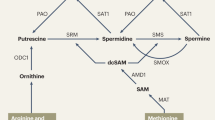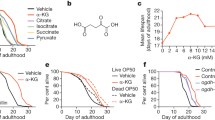Abstract
The exogenous administration of spermidine promotes longevity in many model organisms. It has been proposed that this anti-age activity of spermidine is related to this polyamine’s ability to promote autophagy. Since spermidine is the substrate for the eIF5A post-translational modification by hypusination, we asked ourselves whether mature eIF5A may represent the link between spermidine and autophagy induction. To test this hypothesis, we inhibited the conversion of native eIF5A by a pharmacological approach, using the N1-guanyl-1,7-diamineoheptane (GC7), a spermidine analogue which competitively and reversibly inhibits deoxyhypusine synthase (DHS). In addition, we also employed genetic approaches by ablating both the eIF5A protein itself and DHS, the rate limiting enzyme catalyzing the conversion of lysine to hypusine. Collectively the data presented in this study demonstrate that the mature eIF5A (hypusinated form) is not involved in the autophagic pathway and that the inhibitor of DHS, GC7, produces off-target effect(s) resulting in marked induction of basal autophagy. These data are relevant in light of the fact that GC7 is considered a potent and selective inhibitor of DHS and is a potential candidate drug for cancer, diabetes and HIV therapy.





Similar content being viewed by others
Abbreviations
- eIF5A:
-
Eukaryotic initiation factor 5A
- DHS:
-
Deoxyhypusine synthase
- GC7:
-
N1-guanyl-1,7-diaminoheptane
References
Beninati S, Nicolini L, Jakus J, Passeggio A, Abbruzzese A (1995) Identification of a substrate site for transglutaminases on the human protein synthesis initiation factor 5A. Biochem J 305(3):725–728
Benne R, Hershey JW (1978) The mechanism of action of protein synthesis initiation factors from rabbit reticulocytes. J Biol Chem 253:3078–3087
Caraglia M, Marra M, Giuberti G, D’Alessandro AM, Baldi A, Tassone P, Venuta S, Tagliaferri P, Abbruzzese A (2003) The eukaryotic initiation factor 5A is involved in the regulation of proliferation and apoptosis induced by interferon-alpha and EGF in human cancer cells. J Biochem (Tokyo) 133:757–765
Caraglia M, Park MH, Wolff EC, Marra M, Abbruzzese A (2013) eIF5A isoforms and cancer: two brothers for two functions? Amino Acids 44(1):103–109
Clement PM, Johansson HE, Wolff EC, Park MH (2006) Differential expression of eIF5A-1 and eIF5A-2 in human cancer cells. FEBS J 273(6):1102–1114
Cooper HL, Park MH, Folk JE (1982) Posttranslational formation of hypusine in a single major protein occurs generally in growing cells and is associated with activation of lymphocyte growth. Cell 29:791–797
D’Eletto M, Farrace MG, Falasca L, Reali V, Oliverio S, Melino G, Griffin M, Fimia GM, Piacentini M (2009) Transglutaminase 2 is involved in autophagosome maturation. Autophagy 5:1145–1154
Eisenberg T, Knauer H, Schauer A, Buttner S, Ruckenstuhl C, Carmona-Gutierrez D, Ring J, Schroeder S, Magnes C, Antonacci L, Fussi H, Deszcz L, Hartl R, Schraml E, Criollo A, Megalou E, Weiskopf D, Laun P, Heeren G, Breitenbach M, Grubeck-Loebenstein B, Fahrenkrog B, FroÅNhlich KU, Sinner F, Tavernarakis N, Minois N, Kroemer G, Madeo F (2009) Induction of autophagy by spermidine promotes longevity. Nat Cell Biol 11:1305–1314
Fimia GM, Piacentini M (2010) Regulation of autophagy in mammals and its interplay with apoptosis. Cell Mol Life Sci 67:1581–1588
Gerner EW, Meyskens FL Jr (2004) Polyamines and cancer: old molecules, new understanding. Nat Rev Cancer 4(10):781–792
Guan XY, Fung JM, Ma NF, Lau SH, Tai LS, Xie D, Zhang Y, Hu L, Wu QL, Fang Y et al (2004) Oncogenic role of eIF-5A2 in the development of ovarian cancer. Cancer Res 64:4197–4200
Hill DS, Martin S, Armstrong JL, Flockhart R, Tonison JJ, Simpson DG, Birch-Machin MA, Redfern CP, Lovat PE (2009) Combining the endoplasmic reticulum stress-inducing agents bortezomib and fenretinide as a novel therapeutic strategy for metastatic melanoma. Clin Cancer Res 15(4):1192–1198
Hoque M, Hanauske-Abel HM, Palumbo P, Saxena D, D’Alliessi Gandolfi D, Park MH, Pe’ery T, Mathews MB (2009) Inhibition of HIV-1 gene expression by Ciclopirox and Deferiprone, drugs that prevent hypusination of eukaryotic initiation factor 5A. Retrovirology 6:90. doi:10.1186/1742-4690-6-90
Huang Y, Higginson DS, Hester L, Park MH, Snyder SH (2007) Neuronal growth and survival mediated by eIF5A, a polyamine-modified translation initiation factor. Proc Natl Acad Sci USA 104:4194–4199
Igarashi K, Kashiwagi K (2010) Modulation of cellular function by polyamines. Int J Biochem Cell Biol 42(1):39–51
Jasiulionis MG, Luchessi AD, Moreira AG, Souza PP, Suenaga AP, Correa M, Costa CA, Curi R, Costa-Neto CM (2007) Inhibition of eukaryotic translation initiation factor 5A (eIF5A) hypusination impairs melanoma growth. Cell Biochem Funct 25:109–114
Jenkins ZA, Haag PG, Johansson HE (2001) Human eIF5A2 on chromosome 3q25-q27 is a phylogenetically conserved vertebrate variant of eukaryotic translation initiation factor 5A with tissue-specific expression. Genomics 71:101–109
Kaiser A (2012) Translational control of eIF5A in various diseases. Amino Acids 42(2–3):679–684
Landau G, Bercovich Z, Park MH, Kahana C (2010) The role of polyamines in supporting growth of mammalian cells is mediated through their requirement for translation initiation and elongation. J Biol Chem 285:12474–12481
Lee YB, Folk JE (1998) Branched-chain and unsaturated 1,7-diaminoheptane derivatives as deoxyhypusine synthase inhibitors. Bioorg Med Chem 6(3):253–270
Lee Y, Kim HK, Park HE, Park MH, Joe YA (2002) Effect of N1-guanyl-1,7 diaminoheptane, an inhibitor of deoxyhypusine synthase, on endothelial cell growth, differentiation and apoptosis. Mol Cell Biochem 237(1–2):69–76
Lee SK, Lee J, Lee SI, Bae WJ, Lee YM, Park JS, Lee SK, Park SJ, Min SK, Kim EC (2009) N1-guanyl-1,7,-diamineoheptane, an inhibitor of deoxyhypusine synthase, suppresses differentiation and induces apoptosis via mitochondrial and AMPK pathways in immortalized and malignant human oral keratinocytes. J Oral Pathol Med 38:792–800
Lee NP, Tsang FH, Shek FH, Mao M, Dai H, Zhang C, Dong S, Guan XY, Poon RT, Luk JM (2010) Prognostic significance and therapeutic potential of eukaryotic translation initiation factor 5A (eIF5A) in hepatocellular carcinoma. Int J Cancer 127(4):968–976
Liu YP, Nemeroff M, Yan YP, Chen KY (1997) Interaction of eukaryotic initiation factor 5A with the human immunodeficiency virus type 1 Rev response element RNA and U6 snRNA requires deoxyhypusine or hypusine modification. Biol Signals 6:166–174
Madeo F, Eisenberg T, Büttner S, Ruckenstuhl C, Kroemer G (2010) Spermidine: a novel autophagy inducer and longevity elixir. Autophagy 6(1):160–162
Maier B, Ogihara T, Trace AP, Tersey SA, Robbins RD, Chakrabarti SK, Nunemaker CS, Stull ND, Taylor CA, Thompson JE, Dondero RS, Lewis EC, Dinarello CA, Nadler JL, Mirmira RG (2010) The unique hypusine modification of eIF5A promotes islet b cell inflammation and dysfunction in mice. J Clin Invest 120:2156–2170
Mandal S, Mandal A, Johansson HE, Orialo AV, Park MH (2013) Depletion of cellular polyamines, spermidine and spermine, causes a total arrest in translation and growth in mammalians cells. PNAS 110(6):2169–2174
Moore CC, Martin EN, Lee G, Taylor C, Dondero R et al (2008) Eukaryotic translation initiation factor 5A small interference RNA-liposome complexes reduce inflammation and increase survival in murine models of severe sepsis and acute lung injury. J Infect Dis 198(9):1407–1414
Morselli E, Marino G, Bennetzen MV, Eisenberg T, Megalou E, Schroeder S, Cabrera S, BeÅLnit P, Rustin P, Criollo A, Kepp O, Galluzzi L, Shen S, Malik SA, Maiuri MC, Horio Y, LoÅLpez-OtiÅLn C, Andersen JS, Tavernarakis N, Madeo F, Kroemer G (2011) Spermidine and resveratrol induce autophagy by distinct pathways converging on the acetylproteome. J Cell Biol 192:615–629
Pagliarini V, Wirawan E, Romagnoli A, Ciccosanti F, Lisi G, Lippens S, Cecconi F, Fimia GM, Vandenabeele P, Corazzari M, Piacentini M (2012) Proteolysis of Ambra1 during apoptosis has a role in the inhibition of the autophagic pro-survival response. Cell Death Differ 19(9):1495–1504
Park MH (2006) The post-translational synthesis of a polyamine-derived amino acid, hypusine, in the eukaryotic translation initiation factor 5A (eIF5A). J Biochem (Tokyo) 139:161–169
Park MH, Wolff EC, Folk JE (1993) Hypusine: its post-translational formation in eukaryotic initiation factor 5A and its potential role in cellular regulation. BioFactors 4:95–104
Park MH, Nishimura K, Zanelli CF, Valentini SR (2010) Functional significance of eIF5A and its hypusine modification in eukaryotes. Amino Acids 38:491–500
Patel PH, Costa-Mattioli M, Schulze KL, Bellen HJ (2009) The Drosophila deoxyhypusine hydroxylase homologue nero and its target eIF5A are required for cell gro wth and the regulation of autophagy. J Cell Biol 185:1181–1194
Pegg AE (2009) Mammalian polyamine metabolism and function. IUBMB Life 61(9):880–894
Saini P, Eyler DE, Green R, Dever TE (2009) Hypusine-containing protein eIF-5A promotes translation elongation. Nature 459:118–121. doi:10.1038/nature08034
Scalabrino G, Ferioli ME (1984) Polyamines in mammalian ageing: an oncological problem, too? A review. Mech Ageing Dev 26:149–164
Schnier J, Schwelberger HG, Smit-McBride Z, Kang HA, Hershey JW (1991) Translation initiation factor 5A and its hypusine modification are essential for cell viability in the yeast Saccharomyces cerevisiae. Mol Cell Biol 11:3105–3114
Shi XP, Yin KC, Ahem J, Davis LJ, Stern AM, Waxman L (1996) Effects of N 1-guanyl-1,7-diaminoheptane, an inhibitor of deoxyhypusine synthase, on the growth of tumorigenic cell lines in culture. Biochim Biophys Acta 1310(1):119–126
Shiba T, Mizote H, Kaneko T, Nakajima T, Kakimoto Y (1971) Hypusine, a new amino acid occurring in bovine brain. Isolation and structural determination. Biochim Biophys Acta 244:523–531
Sun Z, Cheng Z, Taylor CA, McConkey BJ, Thompson JE (2010) Apoptosis induction by eIF5A1 involves activation of the intrinsic mitochondrial pathway. J Cell Physiol 223:798–809
Taylor CA, Sun Z, Cliche DO, Ming H, Eshaque B, Jin S, Hopkins MT, Thai B, Thompson JE (2007) Eukaryotic translation initiation factor 5A induces apoptosis in colon cancer cells and associates with the nucleus in response to tumour necrosis factor alpha signalling. Exp Cell Res 313:437–449
Taylor CA, Liu Z, Tang TC, Zheng Q, Francis S, Wang TW, Ye B, Lust JA, Dondero R, Thompson JE (2012) Modulation of eIF5A expression using SNS01 nanoparticles inhibits NF-kB activity and tumor growth in murine models of multiple myeloma. Mol Ther 20(7):1305–1314
Taylor CA, Zheng Q, Liu Z, Thompson JE (2013) Role of p38 and JNK MAPK signaling pathways and tumor suppressor p53 on induction of apoptosis in response to Ad-eIF5A1 in A549 lung cancer cells. Mol Cancer 12:35. doi:10.1186/1476-4598-12-35
Tirupathi Pichiah PB, Suriyakalaa U, Kamalakkannan S, Kokilavani P, Kalaiselvi S, SankarGanesh D, Gowri J, Archunan G, Youn-Soo Cha, Achiraman S (2011) Spermidine may decrease ER stress in pancreatic beta cells and may reduce apoptosis via activating AMPK dependent autophagy pathway. Med Hypotheses 77:677–679
Xie Z, Klionsky DJ (2007) Autophagosome formation: core machinery and adaptations. Nat Cell Biol 9:1102–1109
Zuk D, Jacobson A (1998) A single amino acid substitution in yeast eIF5A results in mRNA stabilization. EMBO J 17:2914–2925
Acknowledgments
This work was supported by grants from MIUR (PRIN 2012), AIRC (MFAG 11743 to MC; IG 2011 N.11409 to MP), FILAS, the Ministry of Health of Italy ‘‘Ricerca Corrente’’ and ‘‘Ricerca Finalizzata’’. The support of the EU Grant “Transpath” Marie Curie project to MP is also acknowledged. We thank Prof. Myung Hee Park from National Institute of Dental and Craniofacial Research “NIDCR” Bethesda, MD who kindly provided the p3XFLAG-CMV-10.1 plasmid encoding for human eIF5A-1; Alessandro Lentini for his graphical support and Maria Concetta Dell’Acqua for her technical assistance.
Conflict of interest
The authors have no conflicts of interest to disclose.
Author information
Authors and Affiliations
Corresponding author
Additional information
S. Oliverio and M. Corazzari have equally contributed to this work.
Rights and permissions
About this article
Cite this article
Oliverio, S., Corazzari, M., Sestito, C. et al. The spermidine analogue GC7 (N1-guanyl-1,7-diamineoheptane) induces autophagy through a mechanism not involving the hypusination of eIF5A. Amino Acids 46, 2767–2776 (2014). https://doi.org/10.1007/s00726-014-1821-0
Received:
Accepted:
Published:
Issue Date:
DOI: https://doi.org/10.1007/s00726-014-1821-0




